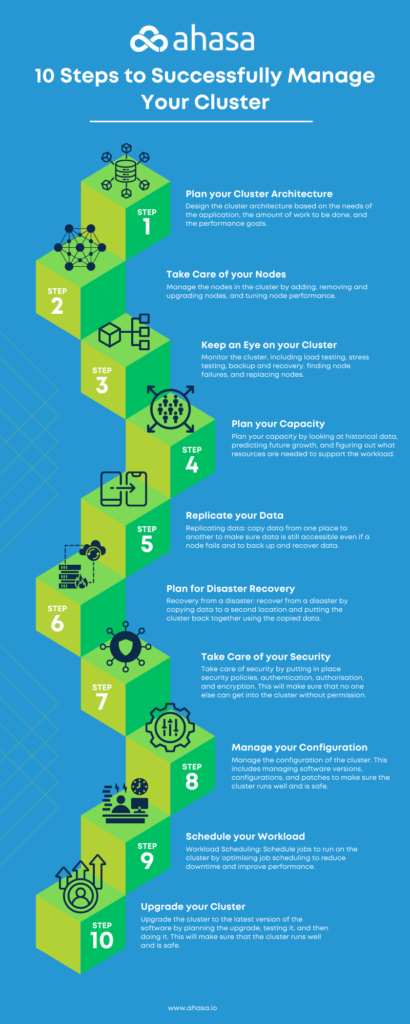Cluster management is the process of taking care of a cluster, which is a group of computers or servers that are linked together. Successful cluster management requires the right allocation of resources, load balancing, scalability, high availability, fault tolerance, performance optimisation, network topology, node management, cluster monitoring, capacity planning, data replication, disaster recovery, security management, and configuration management. This article will look at 10 steps you can take to manage your cluster well.

Step 1: Plan Your Cluster Architecture
The first step is to plan for your cluster’s architecture. Your cluster architecture should be made based on how your application, workload, and performance goals work together. Think about things like virtualisation, containerization, cloud computing, infrastructure as code, automation, DevOps, scalability, and infrastructure as code. A well-designed cluster architecture will make sure that your cluster is optimised to meet your needs for performance and how much work it needs to do.
Step 2: Take Care of Your Nodes
The next step is to take care of your nodes properly. This includes adding and taking away nodes, upgrading nodes, and adjusting how well nodes work. Workload scheduling and real-time analytics are also used to make sure that your cluster is running well and can handle the load.
Step 3: Keep an Eye on Your Cluster
Monitoring is a crucial part of effective cluster management. If you want your cluster to function smoothly, you need to monitor its status regularly. Methods like backup and recovery, failure detection, and node replacement fall under this category. Early detection of problems through diligent cluster monitoring reduces unplanned downtime and maximises system efficiency.
Step 4: Plan Your Capacity
Capacity planning entails calculating how many people, machines, and other assets will be required to handle a given workload. Using historical information and projections about future growth, you can estimate how much capacity you’ll need to handle the expected volume of work. Your cluster can scale to meet your current and future workload requirements with careful planning.
Step 5: Replicate Your Data
If you want your data to be always accessible, replication is a crucial step. You can ensure that your data is still accessible in the event of a node failure by making a copy of it elsewhere. Information can be backed up and restored by using data replication.
Step 6: Plan for Disaster Recovery
To be an effective cluster manager, you need a backup strategy. You need a strategy for getting back on your feet if the worst should happen. This involves making a copy of the cluster’s data at another location and rebuilding it from there.
Step 7: Take Care of Your Security
Security management is an integral part of effective cluster administration. Security policies, user authentication, and authorisation, as well as encryption, must be set up. If your cluster’s security is managed properly, no one else will be able to access your data.
Step 8: Manage Your Configuration
Manage the software versions, configurations, and patches for your cluster by using configuration management. The optimal performance and security of your cluster depend on your configuration management practices.
Step 9: Schedule Your Workload
Scheduling jobs to be executed on your cluster is known as workload scheduling. Optimal scheduling of tasks is essential for minimizing downtime and maximizing output. Good cluster performance is the result of careful scheduling of tasks.
Step 10: Upgrade Your Cluster
To ensure optimal performance and security, you should upgrade your cluster. Upgrading your cluster successfully requires careful preparation, followed by thorough testing.
Conclusion
In conclusion, successful cluster management is a complex process that needs careful planning, execution, and constant monitoring. You can make sure that your clusters are optimised for performance, scalability, high availability, and security by following the 10 steps in this article. By using platforms like Ahasa, organisations can also connect with experts in cluster management to learn more and improve their skills. With the right cluster management, organisations can get a lot of benefits, such as more efficiency, less downtime, and better performance, which will give them a competitive edge in their markets.


